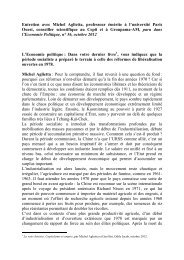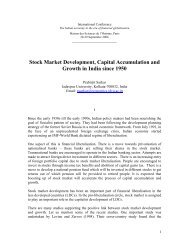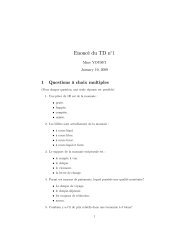Does the Entry Mode of Foreign Banks Matter for Bank ... - EconomiX
Does the Entry Mode of Foreign Banks Matter for Bank ... - EconomiX
Does the Entry Mode of Foreign Banks Matter for Bank ... - EconomiX
You also want an ePaper? Increase the reach of your titles
YUMPU automatically turns print PDFs into web optimized ePapers that Google loves.
are assumed to be independently and identically distributed, but in <strong>the</strong> second stage <strong>the</strong>yare assumed to be a function <strong>of</strong> <strong>the</strong>se firm-specific factors, implying that <strong>the</strong>y are notidentically distributed 7 . The o<strong>the</strong>r problem is that failure to include environmentalvariables in <strong>the</strong> first stage leads to biased estimators <strong>of</strong> <strong>the</strong> parameters <strong>of</strong> <strong>the</strong> deterministicpart <strong>of</strong> <strong>the</strong> production frontier, and also to biased predictors <strong>of</strong> technical efficiency 8 .These criticisms have given rise to a substantial empirical literature on <strong>the</strong>modeling <strong>of</strong> <strong>the</strong> inefficiency effects, leading to <strong>the</strong> emergence <strong>of</strong> a one-stage approach,whereby <strong>the</strong>se inefficiency effects are modeled jointly with <strong>the</strong> frontier 9 .One approach to estimating <strong>the</strong> effect <strong>of</strong> systematic influences on X-inefficiencyis to assume that <strong>the</strong> truncation point <strong>of</strong> <strong>the</strong> one-sided distribution shifts depending on <strong>the</strong>exogenous factors assumed to determine efficiency. This leads to a model <strong>of</strong> <strong>the</strong> <strong>for</strong>m:ln q = x β + v − ui'ii+ ' 2where u ~ N ( z γ , δ ) , z i is a vector <strong>of</strong> systematic influences on mean efficiency. Thisiiuis known as <strong>the</strong> conditional mean approach ( (Kumbhakar, Ghosh, & McGuckin, 1991),(Huang and Liu, 1994), (Battese & Coelli, 1995)). In this type <strong>of</strong> model, <strong>the</strong> two-sidederror is typically assumed to be2(0,v)iN σ . The main weakness <strong>of</strong> this model is that itdoesn’t take into account <strong>the</strong> possibility <strong>of</strong> heteroskedasticity in <strong>the</strong> variances <strong>of</strong> bothtypes <strong>of</strong> error.In a second approach, (Caudill & Ford, 1993), (Caudill, Ford, & Gropper, 1995),and (Hadri, 1999) seek to address <strong>the</strong> problem <strong>of</strong> heteroscedasticity by parameterizing <strong>the</strong>variance <strong>of</strong> <strong>the</strong> inefficiency term. That is, δ ui is assumed to be δ = g( z , γ ) . However,this model cannot incorporate <strong>the</strong> features <strong>of</strong> <strong>the</strong> conditional mean model by assuming<strong>the</strong> truncation point <strong>of</strong> <strong>the</strong> one-sided distribution to be constant.In a third approach, (Wang, 2002, 2003) combine <strong>the</strong> two models above byparameterizing both <strong>the</strong> mean and <strong>the</strong> variance <strong>of</strong> <strong>the</strong> inefficiency term. That means, u i is+ 2'assumed to be u ~ N ( μ , δ ) , where μ = γ and δ2 = exp( z' γ ) . This model af<strong>for</strong>dsiiu iiz iu iu iii7 Unless all <strong>the</strong> coefficients <strong>of</strong> <strong>the</strong> factors are simultaneously equal to zero.8 For more details, see (Caudill, Ford, & Gropper, 1995, and (Wang & Schmidt, 2002).9 Contributions to <strong>the</strong> development <strong>of</strong> <strong>the</strong> one-stage approach include Khumbhakar, Ghosh and McGuckin(1991); (Reifschneider & Stevenson, 1991); (Yuengert, 1993); (Huang & Liu, 1994); (Caudill, Ford, &Gropper, 1995), (Battese & Coelli, 1995), Wang and Schmidt (2002) and (Wang, 2003) amongst o<strong>the</strong>rs.For a discussion and review <strong>of</strong> this literature, see (Kumbhakar & Lovell, 2000), Ch 7.-21-




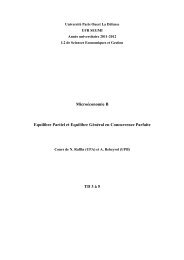

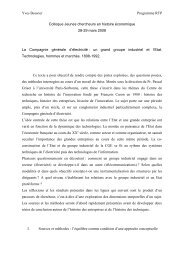

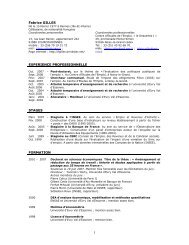
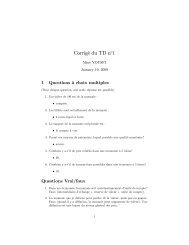
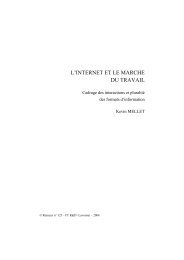
![P * 1 JTZWL_TZY OP^ Sd[Z_Sl^P^ !=m_m]Z^NmOL ... - EconomiX](https://img.yumpu.com/42226403/1/190x143/p-1-jtzwl-tzy-op-sdz-slp-m-mznmol-economix.jpg?quality=85)
